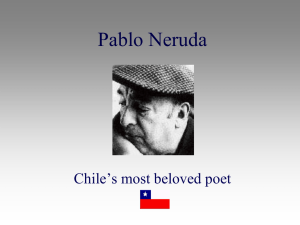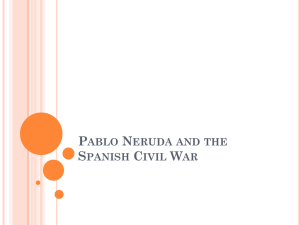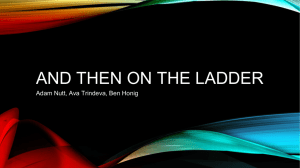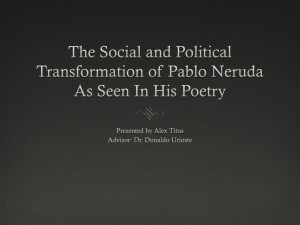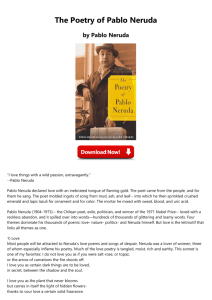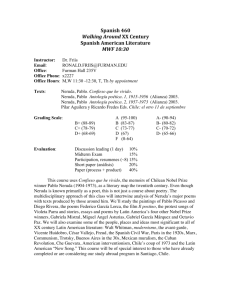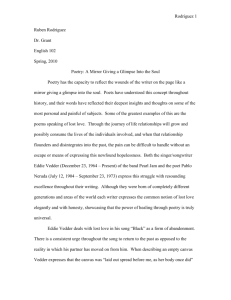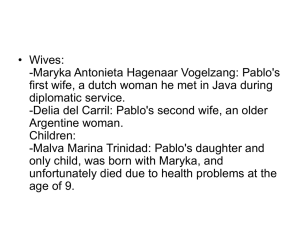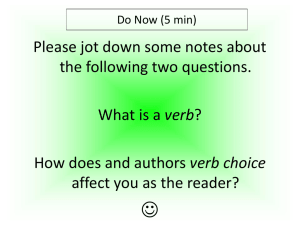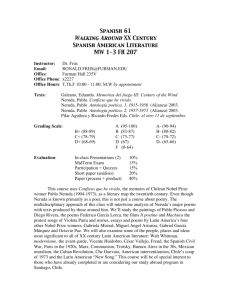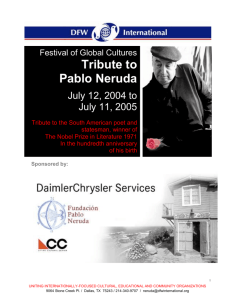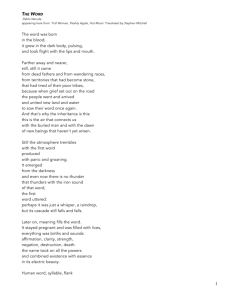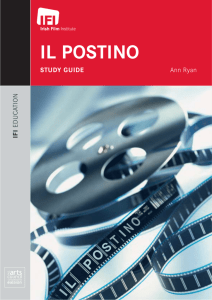The Interactive Oral The interactive oral is a focused class
advertisement
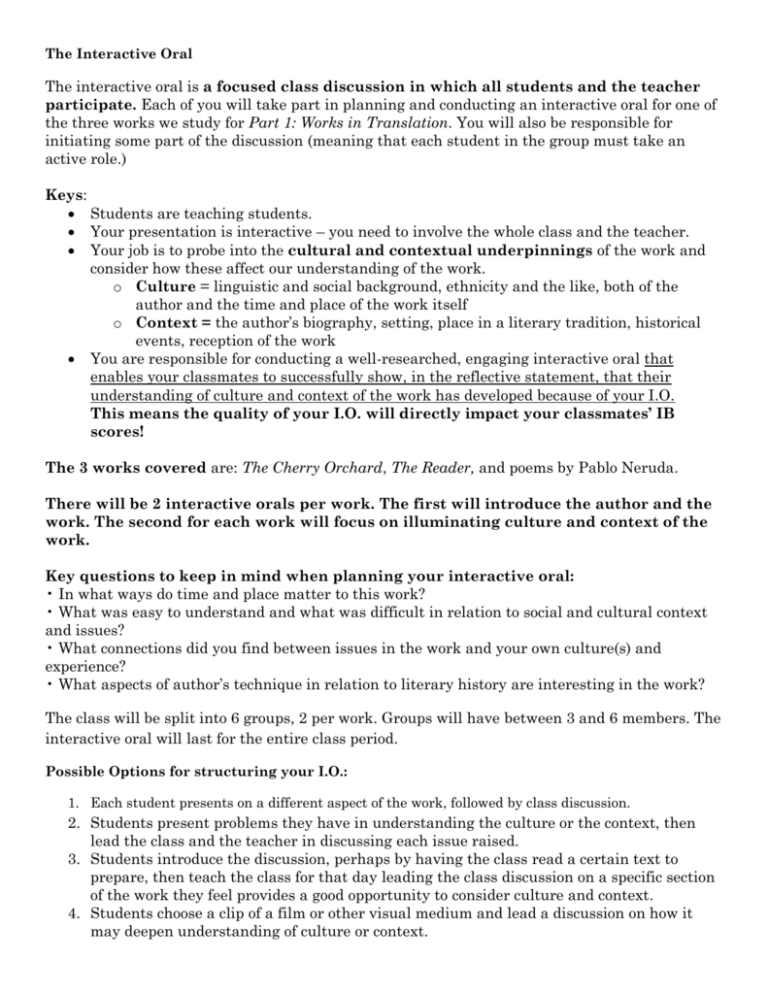
The Interactive Oral The interactive oral is a focused class discussion in which all students and the teacher participate. Each of you will take part in planning and conducting an interactive oral for one of the three works we study for Part 1: Works in Translation. You will also be responsible for initiating some part of the discussion (meaning that each student in the group must take an active role.) Keys: Students are teaching students. Your presentation is interactive – you need to involve the whole class and the teacher. Your job is to probe into the cultural and contextual underpinnings of the work and consider how these affect our understanding of the work. o Culture = linguistic and social background, ethnicity and the like, both of the author and the time and place of the work itself o Context = the author’s biography, setting, place in a literary tradition, historical events, reception of the work You are responsible for conducting a well-researched, engaging interactive oral that enables your classmates to successfully show, in the reflective statement, that their understanding of culture and context of the work has developed because of your I.O. This means the quality of your I.O. will directly impact your classmates’ IB scores! The 3 works covered are: The Cherry Orchard, The Reader, and poems by Pablo Neruda. There will be 2 interactive orals per work. The first will introduce the author and the work. The second for each work will focus on illuminating culture and context of the work. Key questions to keep in mind when planning your interactive oral: • In what ways do time and place matter to this work? • What was easy to understand and what was difficult in relation to social and cultural context and issues? • What connections did you find between issues in the work and your own culture(s) and experience? • What aspects of author’s technique in relation to literary history are interesting in the work? The class will be split into 6 groups, 2 per work. Groups will have between 3 and 6 members. The interactive oral will last for the entire class period. Possible Options for structuring your I.O.: 1. Each student presents on a different aspect of the work, followed by class discussion. 2. Students present problems they have in understanding the culture or the context, then lead the class and the teacher in discussing each issue raised. 3. Students introduce the discussion, perhaps by having the class read a certain text to prepare, then teach the class for that day leading the class discussion on a specific section of the work they feel provides a good opportunity to consider culture and context. 4. Students choose a clip of a film or other visual medium and lead a discussion on how it may deepen understanding of culture or context. 5. Students present a panel in which two or three students take a controversial stance, to which the other panel members respond, followed by class discussion. 6. Students do a short presentation followed by an activity such as role playing in which the whole class participates. 7. Another option of your choice. Creativity is encouraged! This assignment will be worth 50 culminating points (see rubric) plus a 10 point peer grade = 60 pts. total. I.O. DATES: Cherry Orchard The Reader Neruda poetry IO # 1: Fri. Sept. 19 IO # 1: Mon., Oct. 6 IO #1: Mon. Nov. 3 IO #2: Thurs. Sept. 25 IO #2: Mon., Oct. 13 IO #2: Thurs. Nov. 6 Rubric Preparation/Organization: Did the students submit a detailed outline with proper parenthetical citation and a properly formatted works cited page on the day of the presentation? Is the outline well organized? Does the interactive oral proceed in an organized fashion? ____/10 points Knowledge/Understanding: Do students show good knowledge and understanding of cultural and contextual considerations relevant to a literary analysis of the work? Do students show excellent knowledge and understanding of the work itself? Does the interactive oral address cultural and contextual considerations as exemplified in one or more of the 4 key questions? Has the I.O. enabled the class to be successful on the reflective statement? ____/20 points IB Rubric Breakdown: 1-2 little knowledge and understanding 3-4 some knowledge/superficial understanding 5-6 adequate knowledge and understanding of content and some implications of work 7-8 good knowledge and understanding of content and most of implications of work 9-10 excellent knowledge and understanding of content and implications of work Presentation: Is the delivery effective and appropriate for the presentation? Is the presentation engaging? Are strategies such as audibility, eye contact, gesture, and effective use of supporting material applied to hold the class’s interest? Do all students in the group play an active role? Does the presentation have a significant interactive component in which the teacher and the rest of the class are engaged? ____/10 points IB Rubric Breakdown: 1-2 delivery seldom appropriate or interesting 3-4 delivery sometimes appropriate and interesting 5-6 delivery appropriate and clearly interesting 7-8 delivery effective with suitable strategies to interest 9-10 delivery is highly effective with purposeful strategies used to interest audience Language: Is the language clear and appropriate? Do students use a suitable register and style? ___/10 points IB Rubric Breakdown: 1-2 language rarely appropriate; limited register and style 3-4 language sometimes appropriate; some attempt at suitable register and style 5-6 language mostly clear/appropriate; some attention to suitable register and style 7-8 language clear and appropriate; consistently suitable register and style 9-10 language clear and entirely appropriate; consistently effective register and style . FOR EACH WORK: IO #1: Introduces the author and work to the class. You should consider what classmates need to know in order to begin with an understanding of the background of the author and work. To consider (Note: you do not need to cover ALL of this. Remember to focus on creating a wellplanned interactive presentation that teaches your classmates about culture and context): Author biography Literary period or movement the work belongs to Linguistic and social background of the author Background of work: when and why it was written Author’s position in literary history, what author was known for Reception of the work Cherry Orchard: Who was Chekhov? Why was he important? What was he known for? What social class did he come from? What was his religious background? Was he involved in politics? What was his profession? Why is The Cherry Orchard important? How does it fit into Chekhov’s oeuvre? How did audiences respond to it at the time? What was popular theater like in Chekhov’s time and how are Chekhov’s plays different? What new techniques was he using? Who is Stanislavski and what is the Moscow Art Theater and how do they relate to Chekhov? What is the Stanislavsky Method and how does that relate to Chekhov? The Reader: Who is Bernhard Schlink? What is his family, educational and professional background? What does he have to say about the work and why he wrote it? (Avoid spoilers for the class) How has the novel been received? What do people have to say about it? What is Schlink’s relationship with Germany and the German language like? What is Vergangenheitsbewältigung? How did the German post-World War II generation deal with the past? What is the notion of German guilt? Pablo Neruda: Who was Neruda? Why was he important? What was he known for? What style of poetry did he write? Did his poetry change over time? What social class did he come from? What was his religious background? Was he involved in politics? Why did he receive the Nobel Prize? What did he have to say in his Nobel speech? How was Neruda’s poetry received when it was published? Modernista literary movement in Latin America and Neruda’s place in it How did Neruda use the ode? What is an ode? What was interesting about his odes? How was Neruda’s poetry political? IO#2: Teaches classmates what they need to know, (historically, socially and culturally), to understand the contents of the work To consider (Note: you do not need to cover ALL of this. Remember to focus on creating a wellplanned interactive presentation that teaches your classmates about culture and context): Culture and context of the setting, important information so that we understand the context of the work Historical events we need to know about in relation to the work so that we can understand the contents of the work Linguistic and social background of the time and place of the work Cherry Orchard: In what time period is the work set? What historical pieces do we need to understand to understand the characters? What is the Emancipation of the Serfs and when did it happen? Why is it important to the play? How were the social classes in Russia changing over the course of the 19th and early 20th centuries? What social classes do the various characters belong to? What was going on in Russia when the play is set? Is the Russian Revolution relevant to the play? What were the differences in rural and urban Russia in early 1900s? How was Westernization affecting Russia at this time? What was the role of religion in Russia at this time? What was the role of women in 19th and early 20th century Russia? The Reader: (Beware of spoilers) Illiteracy: What does Schlink have to say about it? What were literacy rates in Germany in the 20th century? How were German concentration camp guards recruited? What background did they come from? What were conditions like in the women’s camps? How did the Geneva convention define war crimes? What were the war crimes trials? ( both the Nuremberg trials and later trials in the 1960s) What is denazification? What rules did the Allies place on Germany after WW II? Post-war Germany: What happened in Germany in the 1950s and 1960s? What is the Economic Miracle of the 1960s? What is the 1968 student movement and why is it important? Neruda: Modern (20th century) Chilean history, Pinochet’s coup d’etat and its consequences Different phases of Neruda’s poetry Latin America in the 20th century: influence and impact of colonialism Neruda’s connection to and relationship with Walt Whitman Neruda’s relationship with and attitude towards the United States What is Chile like (pictures) and how does Neruda evoke it in his poetry? Relationship between politics and poetry in Neruda’s poems
